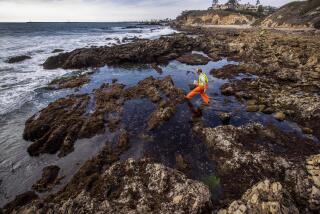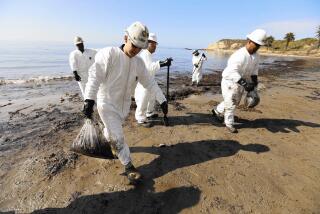Negotiations Between State, Exxon Stall on Guarantee Against Discharge
- Share via
The state and Exxon Shipping Co. had not reached agreement late Thursday on conditions under which the crippled tanker Valdez will be allowed to enter state waters for repairs, primarily because of disagreement over the wording of a demand stipulating that no discharge from the vessel enter the waters.
At issue was the definition of discharge and the company’s inability to guarantee that discharges from the damaged ship would not affect state waters, a source close to the proceedings said.
Meanwhile, divers hired by Exxon to remove six steel plates dangling from the ship’s hull late Thursday were trying to begin working on the tanker, now drifting 7 to 10 miles northeast of San Clemente Island. Rough swells were hampering the efforts, the U. S. Coast Guard reported.
Meeting Here Tuesday
A state Assembly committee on oil spill prevention and response, formed after the Valdez disaster in Alaska and three subsequent spills, said it will meet in San Diego on Tuesday to hear testimony about the condition of the Valdez since it arrived offshore July 9.
Negotiations between the state and Exxon continued late into the night, but were not expected to be completed until today. A state demand that Exxon post a $20-million line of credit for liability, in case it breaks the agreement, was not a critical point of debate, the source said. He added that he was uncertain whether the amount had been negotiated.
Representatives of several state agencies, including the Lands Commission, Department of Fish and Game and Regional Water Quality Control Board, met early Thursday morning and talked with Exxon officials later that afternoon, officials said.
“There are several balls in the air at the same time,” Anthony Summers, a deputy state attorney general, said early Thursday.
Exxon officials would not comment on the negotiations, saying only that the company’s objective is to come up with something it and the state “can live with.”
A clause in the state’s 12-page list of conditions, issued to Exxon on Tuesday, stipulates that “there shall be no discharge of waste from the Exxon Valdez into or affecting (state) waters.” Exxon officials indicated during Thursday’s meetings that, because of the ship’s damaged hull, they could not guarantee that no discharge of any kind would occur, the source said.
The ship would enter state waters--which extend 3 miles from the coast--to remove the plates, reach dry dock in San Diego Bay or both.
Sporadic Discharges
The Valdez is believed to have caused an 18-foot slick that tests showed contained equal parts of weathered crude oil and marine life. Last week the ship sporadically discharged small amounts of a bluish substance from its starboard side. But no discharge has been seen since Sunday, the Coast Guard said, although the tanker is still a suspect as the cause of several sheens spotted earlier this week about 13 miles south of it.
The state has also demanded that Exxon concede that the 987-foot tanker dumped oil during its 2,200-mile trip to San Diego from Alaska. But company officials have been reluctant to make such a concession, describing the discharges and the 18-mile slick as “organic material” with a “hydrocarbon content.”
Exxon officials have maintained that the oil content in the discharges was probably caused by the scouring effect of the sea on the lower depths of the Valdez’s tanks, which still held a waxy residue of oil and had not come clean in Alaska.
Samples taken from the ship’s tanks, from discharge from the tanker and from sheens sighted near the ship are being analyzed, and results are expected within several days.
Offshore, divers hired to remove the steel plates from the hull entered the waters around the tanker, but were forced out by rough swells of up to 7 feet, the Coast Guard said.
Permission to Move
The ship was expected to move late Thursday to calmer waters closer to shore. Coast Guard Cmdr. Don Montoro gave Exxon permission to move to waters within 6 miles of the coast, said Lt. Larry Solberg.
Neither the federal agency nor Exxon was certain when the plate removal could begin, or whether it could be accomplished under open-seas conditions.
Removal of the plates, which peeled back from the hull during the trip from Alaska and now prevent the ship from entering San Diego Bay for repairs, could take five to seven days. The plates jut down as much as 70 feet from the bottom of the ship.
“We still think it’s a legitimate option. But obviously, we want the divers to be safe,” said Jan Cool, a spokeswoman for Exxon Shipping.
The divers had tested the waters Wednesday, and an emergency drill required by the Coast Guard to test the response of the Valdez crew and equipment was completed Thursday, after a supply and recovery boat ready to handle oil discharges or spills was deployed, officials said.
The recovery boat, a salvage vessel operated by the diving company and three tugboats that towed the Valdez from Alaska now surround the drifting ship.
Drill Goes Well
“The drill was satisfactory. Everybody on scene agreed the equipment provided by Exxon . . . was adequate to be able to handle any pollution incident,” Solberg said. “So as long as (the divers) have assessed that it’s safe to do the operation, we’ve given them permission to do it.”
Exxon’s Cool said Wednesday that, although some plate removal might be done outside state waters, the ship still will need to enter the coastal zone to finish the removal or for follow-up repairs.
But no matter where the plates are removed, the ship will face state scrutiny when it enters San Diego Bay, she said.
The tanker was towed from Alaska after hitting a reef and causing the nation’s worst oil spill, along the Prince William Sound shoreline. The ship was scheduled to enter San Diego Bay on July 11 for a $25-million, nine-month repair job at National Steel & Shipbuilding Co., which built the vessel in 1986.
But the discovery July 10 of the jutting plates, as well as the slicks and discharges, delayed its entry.
More to Read
Sign up for Essential California
The most important California stories and recommendations in your inbox every morning.
You may occasionally receive promotional content from the Los Angeles Times.













